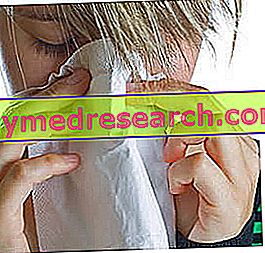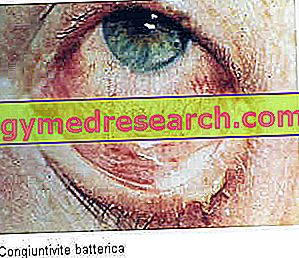Definition
The term "cholecystitis" refers to an inflammatory process against the gallbladder: the inflammation, with an acute or chronic course, is closely related to the formation of stones in the biliary tract and gall bladder. Only rarely does cholecystitis manifest independently of calculosis.
Causes
The vast majority of cases of cholecystitis are caused by the presence of gall bladder and / or biliary tract stones, a consequence, in turn, of accumulations of cholesterol and bile salts precipitated by the bile: blockage of the bile duct causes inflammation of the gallbladder . Among the other causes involved in cholecystitis, we mention: bacterial infections of the gall bladder, gallbladder surgery, exaggerated allergic reactions, bile duct narrowing, gallbladder tumor.
- Risk factors: AIDS, previous biliary colic, fast weight loss, fertile / elderly age, recent pregnancy, obesity, female sex
Symptoms
Acute episodes of cholecystitis manifest themselves with chills, abdominal pain circumscribed to the upper right quadrant (which worsens with palpation) and fever, often associated with abdominal swelling, lack of appetite, nausea, sweating and vomiting. In the lithiasic form of cholecystitis (independent of calculosis), the patient complains of more or less marked jaundice. The chronic form of cholecystitis is characterized by repeated acute inflammatory processes and / or chronic irritation, sometimes asymptomatic.
- Complications: gangrene and perforation
Information on Cholecystitis - Drugs for the Treatment of Cholecystitis is not intended to replace the direct relationship between health professional and patient. Always consult your doctor and / or specialist before taking cholecystitis - cholecystitis drug.
drugs
Treatment for the treatment of cholecystitis almost always involves hospitalization of the patient, in order to block the progression of inflammation and reverse the pathology; in fact cholecystitis is among the pathologies that require immediate emergency treatment, precisely because a degeneration of the inflammatory process could cause serious complications, such as perforation and gangrene.
The patient's hospitalization aims to lighten the symptoms and remove inflammation, and consists of a series of measures:
- Fasting
- Complete physical rest
- Replenishment of mineral salts (electrolytic therapy)
- Administration of antibiotics
- Administration of pain-relieving drugs to control pain: generally NSAIDs are taken
- Administration of antispastic drugs
In emergency situations - in which an accumulation of pus is observed due to the presence of pyogenic bacteria, a peritonitis, a perforation or a collection of mucus with organ hypertension - an immediate surgical intervention may be necessary, consisting in the removal of the gallbladder (cholecystectomy).
After the operation, it is recommended to respect a rest period and to follow a healthy and balanced diet, poor in hyperlipidic and high-protein foods.
In general, the treatment for cholecystitis depends on the severity of the inflammation: the mild forms can be treated with antibiotics or with a mini surgery; moderate and severe cholecystitis is generally treated with a laparoscopic procedure (cholecystectomy: gallbladder removal)
Antibiotics : indicated for the treatment of cholecystitis in the event of bacterial superinfections; cephalosporins and penicillins are the most widely used antibiotic drugs for this purpose:
- Cephalosporins
- Cefazolin (eg Cefazolin GRP, Cefazil, Nefazol): belongs to the first generation cephalosporin class. To remove the pathogen responsible for cholecystitis, it is recommended to take the drug at a dose of 12 grams intravenously every 6-8 hours, for 2 weeks. Do not exceed 12 grams per day. The mere administration of antibiotics for the treatment of cholecystitis is questionable: only the surgical operation is able to completely cancel the inflammation.
- Cefoxitine (eg Mefoxin): second-generation cephalosporin used in therapy for the treatment of cholecystitis. The indicative dose foresees to take 1-2 grams of drug intravenously or intramuscularly every 12 hours, for 3-7 days (in case of absence of complications) or for 2-3 weeks (for severe cholecystitis). Consult your doctor.
- Cefotetan (eg Cepan, Darvilen): second-generation cephalosporin. Depending on the severity of the cholecystitis, take a dose varying from 500 mg to 4 g of drug per day intravenously or intramuscularly, possibly split into two doses over 24 hours.
- penicillins
- Piperacillin (eg Limerik, Picillin, Ecosette): the drug is a semi-synthetic penicillin with a broad spectrum of action, indicated for bacterial infections in the context of cholecystitis (species supported by Pseudomonas aeruginosa, Klebsiella, Enterobacter, Escherichia coli, Neisseria gonorrhoeae etc.). Indicatively, take a dose varying from 125 to 200 mg / kg of drug per day intravenously, in divided doses every 6-8 hours, for 7-10 days.
- Ampicillin (eg Ampilux, Amplital, Unasyn): indicatively, take 1-2 grams of drug intravenously every 4-6 hours, in association with other antibiotics. The choice of an antibiotic depends on the nature of the infection. Continue therapy for 10-14 days.
- Netilmicina (eg Zetamicin): available as an intravenous or intramuscular solution for injection. Indicatively, for infections affecting the biliary tract in general and for cholecystitis in particular, the indicative dose of the drug envisages taking 2-3 mg / kg every 12 hours; alternatively, it is possible to take 1.3-2 mg / kg of active ingredient every 8 hours, for a maximum of 4-6 mg / kg per day. Consult your doctor.
Analgesics and antispasmodics for the control of pain associated with cholecystitis
- Meperidine or Petidina (eg Demerol, Petid C): opioid analgesic drug to be taken orally at a dose of 50-100 mg every 4 hours, as needed. Or, intramuscularly / intravenously or subcutaneously, at a dosage of 25-100 mg every 4 hours.
- Diclofenac (eg Pain Reliever, Flogofenac Retard, Momenlocaldol, Voltaren) preferable to pethidine. Take 50 mg of drug orally 3 times a day (tablets); in some patients, an initial dose of 100 mg is required, and then changed to 50 mg. After the first day, the total daily dose should not exceed 150 mg.
- Scopolamine butylbromide (eg Buscopan, Addofix, Erion): indicated to relax the smooth muscle of the genitourinary tract, also in the context of cholecystitis. It is recommended to take 1-2 tablets of 10 mg 3 times a day for adults and children over the age of 14 years. In the case of children between the ages of 6 and 14, it is essential to consult a doctor before taking the drug.
- Paracetamol or acetaminophen (eg Tachipirina, Buscopam Compositum): fever is a very common phenomenon in acute episodes of cholecystitis; for this reason, it is recommended to take paracetamol: indicatively, take the drug orally in the form of tablets, syrup, effervescent sachets or suppositories; it is recommended to take paracetamol at a dosage of 325-650 mg every 4-6 hours for 6-8 consecutive days.



